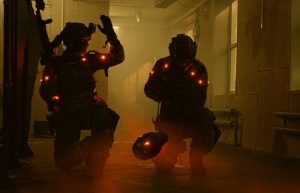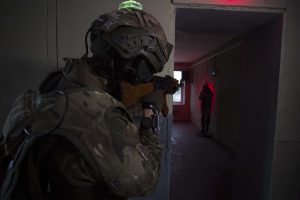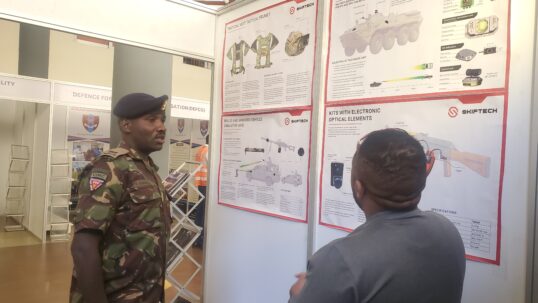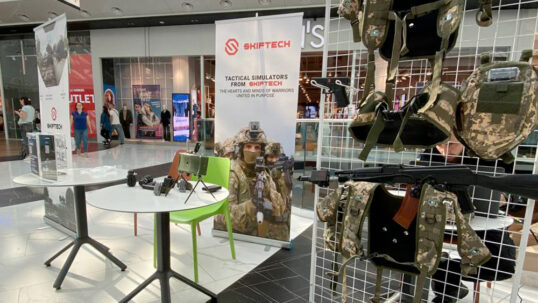Author: Bojan Stojkovski
The original article published on IT.MK.

Land-based kamikaze drones, invisibility cloaks, the use of AI to track enemy troops… all this is not science fiction, but a reality that can be seen on the battlefield in Ukraine during the war that has been going on for 20 months.
At the same time, this war became the first major military conflict where technology equipped with AI, such as unmanned aerial vehicles or drones, play a huge role, primarily because their use reduces the risks for human personnel.
Drones — guardian angels of the Ukrainian sky
With Ukrainian cities constantly targeted by Russian airstrikes, drones are becoming a key part of Ukraine’s arsenal, deployed in a wide range of tasks – from surveillance and attacks on Russian forces, to delivery and evacuation assistance.
The necessity of drones as Ukraine’s primary counter-defense against the 10 times bigger Russian air force has increased the number of relevant Ukrainian startups working in this sphere. Currently, over 200 Ukrainian startups are producing drones equipped with AI, and semi-autonomous capabilities in close collaboration with military units that allow them to make immediate adjustments to reduce the vulnerabilities of the Ukrainian war.
The expeditious results brought by the application of this technology also resulted in external investments, so the former adviser to the Pentagon for technologies with artificial intelligence and former CEO of Google, Eric Schmidt, financed a Ukrainian startup for defense technology with 10 million dollars.
There’s also an investment by Turkish defense giant and drone maker Baykar, which has invested nearly $100 million to build a research center and advanced manufacturing center in Ukraine by 2025.
Such developments inspired the creation of the Brave1 defense cluster – a coordination platform created by the government of Ukraine to promote cooperation between all defense technology actors in the country. More importantly, Brave1 is here to fund all innovative solutions and products by Ukrainian startups working in the field of defense technology.
One recent example is the introduction of a new ground drone that carries bombs and anti-tank mines to combat Russian tanks. The drone, called Ratel S or Honey Badger, can carry up to 35 kilograms, with a maximum speed of 25 kilometers per hour.
“The main idea is to use the robot as a mobile warhead that carries anti-tank mines or other explosive devices,” explained Brave1.
Then there are innovations such as an invisible cloak that protects Ukrainian soldiers from thermal imaging.
“The Ukrainians have created a super defense against Russian thermal cameras and drones with thermal cameras. The cloak blocks heat radiation and makes fighters invisible to the enemy,” said Ukrainian Minister of Digital Transformation, Mykhailo Fedorov.
The fight against Russian disinformation
Startups like Mantis Analytics, on the other hand, contribute to the war against Russia through software products that serve to combat Russian disinformation.
“As Mantis Analytics we are committed to cognitive security. Right now we are at the heart of the fight against disinformation. Our task involves not only withstanding all attacks, but also extracting valuable insights from the current situation. At the same time, we are actively engaged in testing and refining new technologies that could prove advantageous in other regions as well,” says Maxim Tereshchenko, CEO of Mantis Analytics.
According to him, many of these technologies have been put to the test in real combat conditions in Ukraine, before moving on to industrial development and transition to the corporate sector.
Among the innovative solutions developed by Ukrainian startups are HIMERA, a secure emergency communication system developed by Misha Rudominsky, also a co-founder of the veteran Promin Aerospace. Army SOS’s “Kropiva” software has become an essential tool for planning and orientation, used by thousands of Ukrainian soldiers.
According to Tetiana Ostra, founder of the Boriveter Military School, innovation is not limited to weapons – it also extends to training methods. Ukraine is exploring advanced simulation systems from countries such as Sweden and the United States, emphasizing the importance of strategy and a broader perspective in military training.
“Since I am representing a training organization, I would really like to focus on innovation in training and not having to go out on the battlefield and use heavy machinery, then weapons and having to use grenades, bullets for this training, etc. We have to focus on this, primarily because training can be so much more effective – it’s about strategy, about seeing the bigger picture and benefit bringing more innovations and technologies to the battlefield”, emphasizes Ostra.
Simulation Systems — Skiftech’s evolution from entertainment to combat

Skiftech is one of the companies that has been working on the creation of tactical simulation systems for a long time. Founded in 2013, the company first began developing military Laser tag simulation equipment and virtual reality (VR) equipment.
“In 2013, instructors from the Kharkiv Institute of Tank Troops approached our team for the development of military Laser tag equipment. As a student, I was there for military training and got to know their teachers and instructors. At that time, we already had experience in manufacturing Laser tag equipment for businesses, and by the way, we continue to pursue this venture today, exporting commercial Laser tag and VR equipment to more than 70 countries worldwide. However, we lacked a deep understanding of military technologies, which presented a significant challenge for us. We started to study this field, design and develop the first simulator prototypes. A year later, we supplied the institute with tactical simulators based on laser technology. That’s how Skiftech emerged and since then it continues to develop”, says Michael Obod, one of the co-founders of the Ukrainian startup.
In 2014, Russia launched its first invasion of Ukraine and at that moment Skiftech decided to focus on solutions for the development of defense technology in the country.
“Our goal was to create solutions that could simulate combat conditions, improve coordination and enable military personnel to practice different scenarios. We received similar requests from the military. We often emphasize that it is better to experience ‘virtual death’ hundreds of times during training than a laser shot in order to increase the chances of surviving a real combat situation with the enemy,” emphasizes Obod.
Some of the company’s employees are currently serving in the military, and all of this further helps Skiftech develop and upgrade existing products.
“They are designed through hands-on feedback from active-duty soldiers, unit commanders and training academy instructors, using even the smallest details. This approach saves lives by making simulators as realistic and effective as possible,” says Obod.
Skiftech is also trying to incorporate AI into the development of their products, which according to Obod will become one of the primary trends when it comes to the further development of defense technology.
“Our primary goal with artificial intelligence is to optimize equipment efficiency. The primary challenge is to respond quickly to the demands of the military and to create equipment for the development of tactics and weapons on the front. So, our mission is to provide valuable support to our veterans by creating equipment that could potentially save their lives in the future,” Obod concludes.

